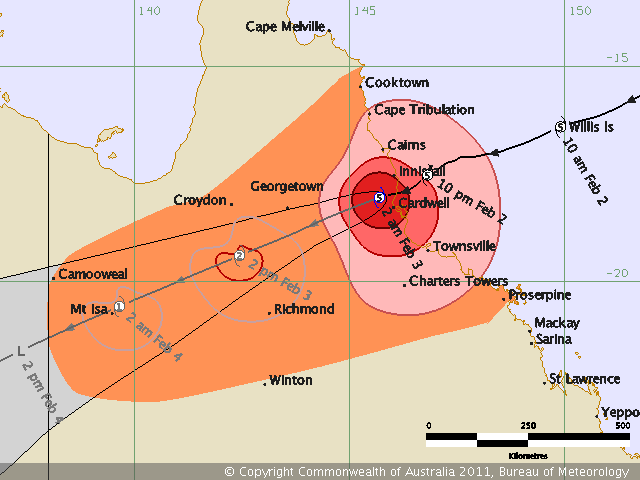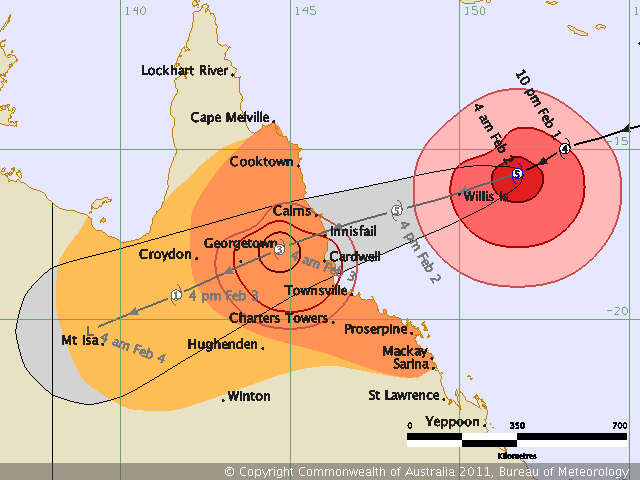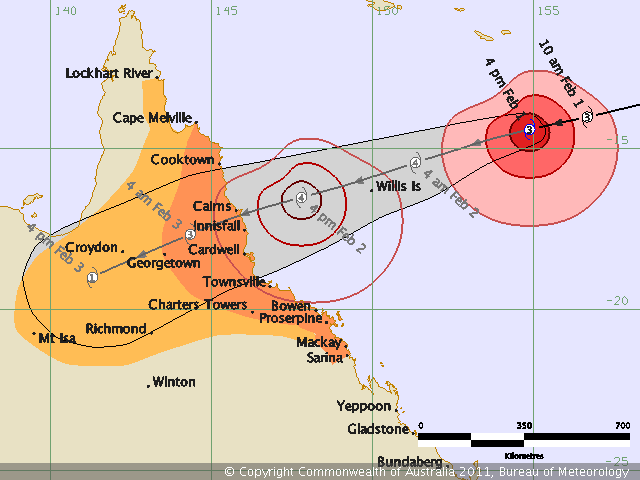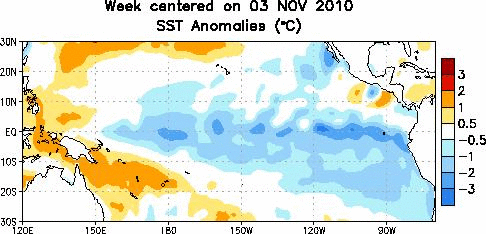02.02.11
Posted in Non-US Weather, Tropical Weather at 10:24 am by Rebekah
Category 5 Tropical Cyclone Yasi (equivalent of a Cat. 4 on the Saffir-Simpson scale) made landfall near Mission Beach, between Innisfail and Cardwell, Queensland about an hour and a half ago (12:30 am local time).
Here is a summary of the cyclone’s landfall and expected impacts.

12-hr infrared satellite loop of Yasi nearing the Queensland Coast, from the Bureau of Meteorology (click to enlarge)
Stats around landfall:
- Maximum sustained 10-minute wind speed: 127 mph (202 kph)
- Maximum 3-second wind gust: 178 mph (285 kph)
- Central pressure: 930 mb
- Maximum storm surge: 30 ft (9 m)

1-hr radar loop showing Yasi making landfall, from Weatherzone (click to enlarge)

Meteogram (history of weather) for Lucinda Point over the last 24 hours, from Weatherzone…note the spike in temperature, dewpoint, and rain as the eye passes over (click to enlarge)

Meteogram for Lucinda Point over the last 24 hours, from Weatherzone…note the drop (and subsequent rise) in pressure and the peak in winds as the eye passes over…the lowest pressure recorded was 977 mb, the highest wind was 135 kph (84 mph), and the highest wind gust was 185 kph (116 mph) (click to enlarge)

Latest forecast track and intensity for Yasi, as of 2 am local time, from the Bureau of Meteorology (click to enlarge)
Even once the winds slow down some, Yasi will bring a lot of rain to northeastern Queensland; the cyclone also looks like it will stall for a bit in the mountains, allowing even more rain to fall. Models show that the area could receive as much as a foot of rain, and some localized areas could even receive 2 feet or more of rain.
Permalink
02.01.11
Posted in Non-US Weather, Tropical Weather at 1:27 pm by Rebekah
Severe Tropical Cyclone Yasi is a Category 5 tropical cyclone this morning (Australian scale …Category 4 on the Saffir-Simpson scale).
The maximum sustained winds are 138 mph (221 kph), and the minimum central pressure is 924 mb. Yasi is moving towards the west-southwest at about 17 mph (28 kph).

Yasi, at 1732 Z (3:32 am Australian EST), from UW-CIMSS (click to enlarge)
Yasi’s wind field is enormous, so don’t just focus on where the eye is headed…here’s some excerpts from the latest (5:01 am Australian EST) tropical cyclone advice from the Bureau of Meteorology:
“SEVERE TC YASI IS A LARGE AND VERY POWERFUL TROPICAL CYCLONE AND POSES AN EXTREMELY SERIOUS THREAT TO LIFE AND PROPERTY WITHIN THE WARNING AREA, ESPECIALLY BETWEEN PORT DOUGLAS AND TOWNSVILLE.”
“THIS IMPACT IS LIKELY TO BE MORE LIFE THREATENING THAN ANY EXPERIENCED DURING RECENT GENERATIONS.”
This is obviously some pretty strong wording, so if you are in the path of this cyclone, please take all warnings seriously, and find higher ground if you live near the sea. The storm surge is expected to be very high and some areas could get as much as 3 feet of rain, so there will be some flooding up and down the coast (and further inland, wherever the heaviest rains set up).

Yasi’s latest forecast track and intensity, from the Bureau of Meteorology (click to enlarge)
Permalink
Posted in Non-US Weather, Tropical Weather, Weather News at 8:00 am by Rebekah
This week’s post in the global weather and climate series features Cairns, Queensland, Australia.

Cairns, from Mt. Whitfield, looking east. From Wikipedia
Cairns is situated on the northeastern coast of Queensland, on the eastern side of the Cape York Peninsula. The Great Dividing Range is to the west, and the Great Barrier Reef is just off the coast. Cairns is home to over 164,000 people.
Cairns was founded in 1876, and was later used by the Allied Forces during World War II as a base for Pacific operations. Today, the city is an important international tourism destination. Following Sydney, Melbourne, and Brisbane, Cairns is the fourth-most popular destination in Australia for foreign tourists.
A few more facts about Cairns (from Wikipedia):
- Time zone: Australian Eastern Standard Time (UTC+10)
- Average elevation: sea level
- Climate zone: Tropical monsoon
- Average high temperature: 84 °F (29 °C)
- Average low temperature: 69 °F (21 °C)
- Average annual high/low temperature range: 78 to 89 °F (26 to 31 °C) / 63 to 75 °F (17 to 24 °C)
- Average annual precipitation: 79 inches (2,011 mm)
Weather: February is climatologically the wettest month of the year for Cairns. The city’s monsoon climate means that there is a very pronounced wet season in the summer, with a dry season in the winter.
While not as affected by the Australian flooding as some points further south, Cairns has received copious precipitation recently. The rain is not going to stop any time soon, unfortunately; there is a chance of showers and thunderstorms every day and night for the next week or so, and Tropical Cyclone Yasi could bring as much as a foot or more of rain for some places around and just east of Cairns.
Models show Yasi could stall a bit in the mountains for about 12 hours or so after making landfall, bringing greater chances for large rain totals. Cairns will also get some strong winds (maximum winds could reach 100 mph, with higher gusts) from Yasi, as the cyclone is expected to make landfall as a Category 4.

See also yesterday’s post, Strengthening Tropical Cyclone Yasi.

Tropical Cyclone Yasi, at 00Z (10am on the 1st, Australian Eastern Standard Time), from MODIS (click to enlarge)
For the latest on Tropical Cyclone Yasi, see the Australian Bureau of Meteorology.
For weather maps and information on current and forecast Cairns weather, see the Australian Bureau of Meteorology, Weatherzone, Weather Underground, and Weather Online UK.
For more information on Cairns, here’s a link to Wikipedia.
Next Tuesday I plan to take a look at the climate and weather in another part of the globe. As always, if you have any suggestions for future cities, please leave a comment!
Permalink
01.31.11
Posted in Non-US Weather, Tropical Weather at 2:47 pm by Rebekah
Yesterday I posted forecasts for a new tropical cyclone, Yasi, that had formed near Vanuatu. Yasi has strengthened considerably over the past 12 or so hours, and is currently a Category 3 severe tropical cyclone on the Australian scale (Category 2 on the Saffir-Simpson scale), with a maximum 10-minute wind speed of 98 mph (156 kph) and a minimum pressure of 960 mb. Maximum wind gusts are estimated to be near 138 mph (221 kph). Yasi is moving westward at 25 mph (40 kph).

Infrared satellite image of Yasi at 1830 Z (4:30 am Australian Eastern Standard Time), from UW-CIMSS (see this website for the latest data such as sea-surface temperatures, wind shear, satellite images, etc.)
Yasi’s track has shifted a bit further north, so the tropical cyclone is now forecast to make landfall Wednesday night / Thursday morning (Australian time) near Cairns/Innisfail, Queensland. Yasi is over some pretty warm waters and a low shear environment (see this blog post for info on how tropical cyclones form and strengthen), so more strengthening is expected.
The Australian Bureau of Meteorology is calling for Yasi to peak in strength late Wednesday afternoon (Australian time) as a Category 4 cyclone (on both the Australian and the Saffir-Simpson scales) with maximum sustained winds of 121 mph (193 kph) and a minimum central pressure of 939 mb. The cyclone may weaken just a bit before making landfall, but it is likely that it will make landfall as a Category 4 storm.

Yasi’s forecast strength and track, issued by the Bureau of Meteorology at 4 am Australian Eastern Standard Time

Surface map forecast for the next few days, from the Bureau of Meteorology
GFS model’s 12Z run (valid at 18Z Wednesday, or 4 am Thursday, Australian Eastern Standard Time), showing a more southern track, more towards Townsville (map from Weather Online UK):

ECMWF model’s 12 run (valid at 12Z Wednesday, or 10 pm, Australian Eastern Standard Time), from Weather Online UK:

To keep up-to-date with the Bureau of Meteorology’s latest forecast tracks and tropical cyclone advice, see the tropical cyclone section of their webpage. Another good website with tropical cyclone tracks and information, that I have yet to mention, is Weather Underground.
Permalink
01.30.11
Posted in Non-US Weather, Tropical Weather, Weather Forecast at 1:46 pm by Rebekah
As if Queensland hasn’t already seen enough rain and flooding to last a lifetime, a new tropical cyclone is forming in the southeast Pacific, and models show it strengthening to possibly a Category 3 (Australian) cyclone (probably only Cat. 1 on the Saffir-Simpson scale) just before making landfall somewhere near or south of Townsville, Queensland on Thursday.
This tropical cyclone, Yasi (on the Fiji names list), may bring 70+ mph (110+ kph) winds and heavy rain when it makes landfall. The GFS model is currently predicting a minimum pressure of 976 mb, while the ECMWF is predicting a minimum pressure of 972 mb, with a slightly faster track.
Here’s the GFS model’s forecast (from Weather Online UK) for surface pressure and precipitation, at 18Z on Wednesday (4 am Thursday, local time)…the cyclone is predicted to make landfall about 6 hours later:

Here’s an ECMWF forecast for surface pressure, for comparison…the nearest time they have is for Thursday at 00Z (10 am Thursday, local time):

Here’s what the Australian Bureau of Meteorology is predicting for the next few days (for those of you in the U.S., the local “Eastern Standard Time” on this map is 15 hours ahead of the U.S. Eastern Standard Time):

Waters off the eastern coast of Queensland are warmer-than-normal, aiding in the strengthening of Yasi just before landfall.
Tropical sea-surface temperature anomalies, from the Climate Prediction Center:

Here’s another link, from NCDC, showing sea-surface temperature anomalies across the entire globe over the past 5 weeks.
Permalink
« Previous Page — « Previous entries « Previous Page · Next Page » Next entries » — Next Page »


















